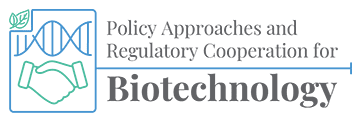Description
Possibly the most challenging approach to regulatory coordination for APEC economies to consider is collaboration on risk/safety assessments. There are a number of different ways to collaborate on risk/safety assessments, as described in this section: safety assessment review; parallel safety assessment; shared safety assessment; joint safety assessment. These options and the benefits and challenges of each are also described in the OECD document on considerations for collaborative work on safety assessments of food and feeds derived from rDNA plants (OECD 2021).
Benefits and Challenges of Collaboration on Risk/Safety Assessment
Some of the benefits and challenges that can be associated with collaboration on risk/safety assessment are described below. The benefits of these generally increase as the complexity at multiple levels also increase (Figure 1). As APEC member economies evaluate the feasibility of pursuing collaborations on risk assessment, they will want to consider how these different benefits and challenges factor into the process depending on the type of collaboration being considered.
- Benefits of collaboration on risk/safety assessment:
- Efficiency gains in the assessment process
- Potential to reduce regulatory burden
- Improved synchronization of authorizations
- Mutual capacity building and learning
- Stronger working relationships among between economies
- Provides a regulatory environment that supports innovation
- Increased public confidence in regulatory decisions
Challenges of collaboration of risk/safety assessment:
- Legal issues, legislative frameworks
- Operational differences between agencies
- Logistical and practical challenges
- Initial demand on resources
- Level of commitment
- Level of experience and expertise
Safety Assessment Review
Inter-agency peer review as a way to collaborate on risk/safety assessment is plainly a matter of agencies from different member economies having an arrangement in place to share safety assessments with each other for review. It is an example of sharing information through direct communication, as described earlier in this document. Although sharing safety assessments for review is also part of other types of risk/safety assessment collaboration, it can be in itself a form of collaboration. As part of the agreement, the reviewing agency may be expected to share comments or a critique of the assessment. Member economies may enter into such an arrangement in the interest of providing some assurance that the review and the review process are credible and acceptable according to pre-determined standards. Sharing safety assessments for review can also be a particularly useful tool for capacity building when more advanced member economies agree to share safety assessments with less experienced economies. In cases where economies choose to accept the review of another agency for their own decision-making, as described in the section on technical policy alignment.
Following a review of a safety assessment, an economy may also choose to consider the safety assessment, all or in part, for their own decision making of a given biotech product, as a simplified procedure to risk/safety assessment. In these cases, the economy accepting the review of another will have to coordinate closely with the assessing economy to understand the technical policies for safety assessment and ensure alignment of the process with their own. For this process to work, the reviewing economy will establish clear criteria based on the expectation for an assessment that must be met for the economy to accept the assessment for a decision. The review process then becomes a matter of reviewing the assessment against the established criteria.
Parallel Safety Assessment
This type of collaboration on risk/safety assessment is a pre-determined process by which two or more member economies complete their own safety assessment, but they do this in a coordinated fashion according to a mutually agreed timeline. It is similar to inter-agency peer review, but requires considerably more commitment from the member economies involved because there would be a timeline in place and regularly scheduled inter-agency discussions to complete the review within a prescribed period of time. More time would be required by the member economies to compare and contrast their established approaches to risk/safety assessment before agreeing to this type of collaboration. This arrangement would also require cooperation of a product developer willing to submit an application simultaneously to both economies.
Shared Safety Assessment
Shared safety assessments are assessments developed together by two or more economies, where one economy takes the lead on drafting the risk/safety assessment and this draft is shared with another member economy for their review. The collaborating agencies then work jointly to finalize the assessment, and this final safety assessment is used independently by the agencies in their decision-making process. As with the parallel safety assessment, this type of collaboration requires a time investment up front to compare each economies approach and requires an agreement with the product developer.
Joint Safety Assessment
The joint safety assessment combines the elements of all previously described ways to collaborate on risk/safety assessments. In this type of collaboration, two or more economies conduct an assessment simultaneously with each agency taking the lead on specific elements of the assessment. Once the draft is completed it is reviewed and finalized by all economies involved and the final assessment independently by the agencies in their decision -making processes. This approach requires the most commitment from each of the collaborating economies, as all economies involved must contribute expertise and follow a close timeline, in order to finalize the assessment.
